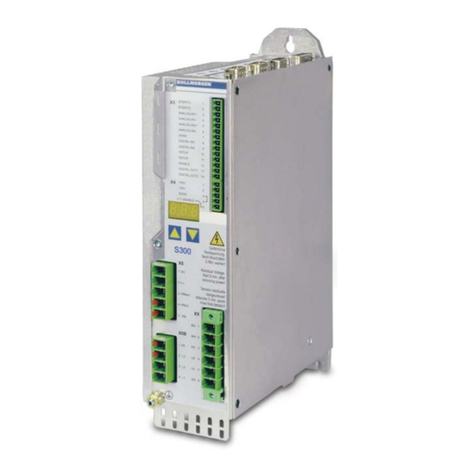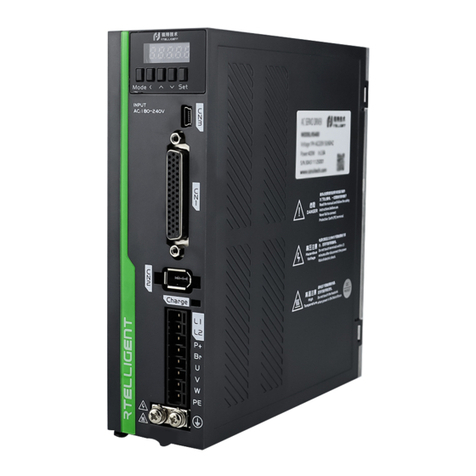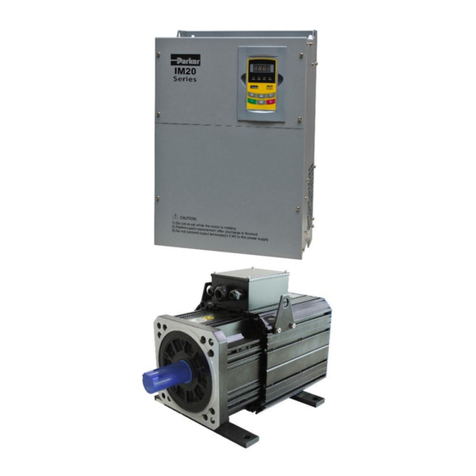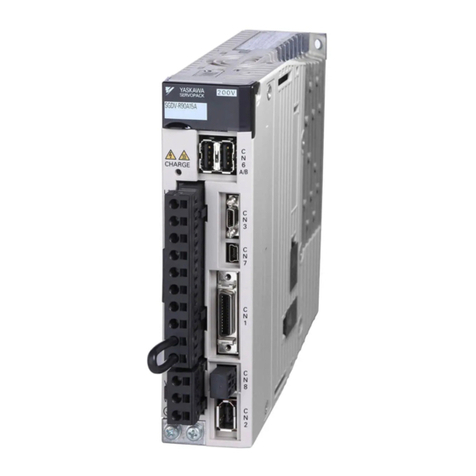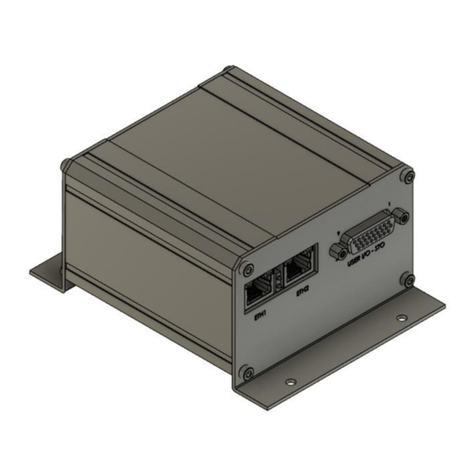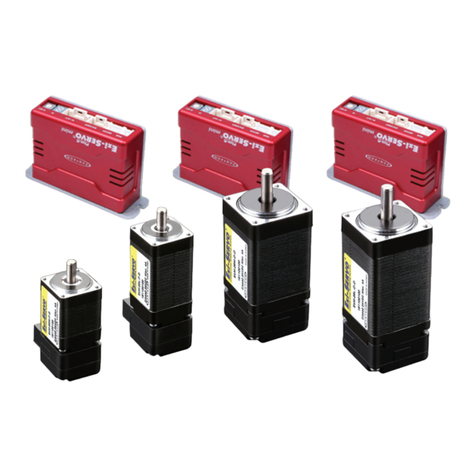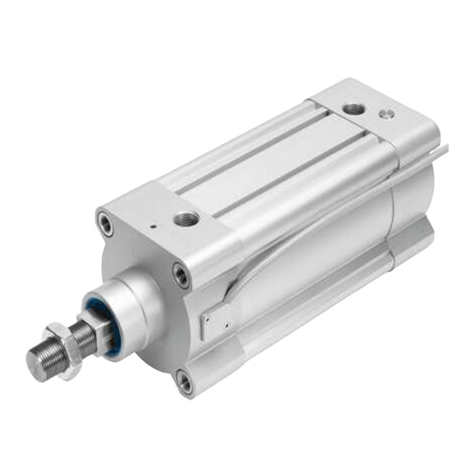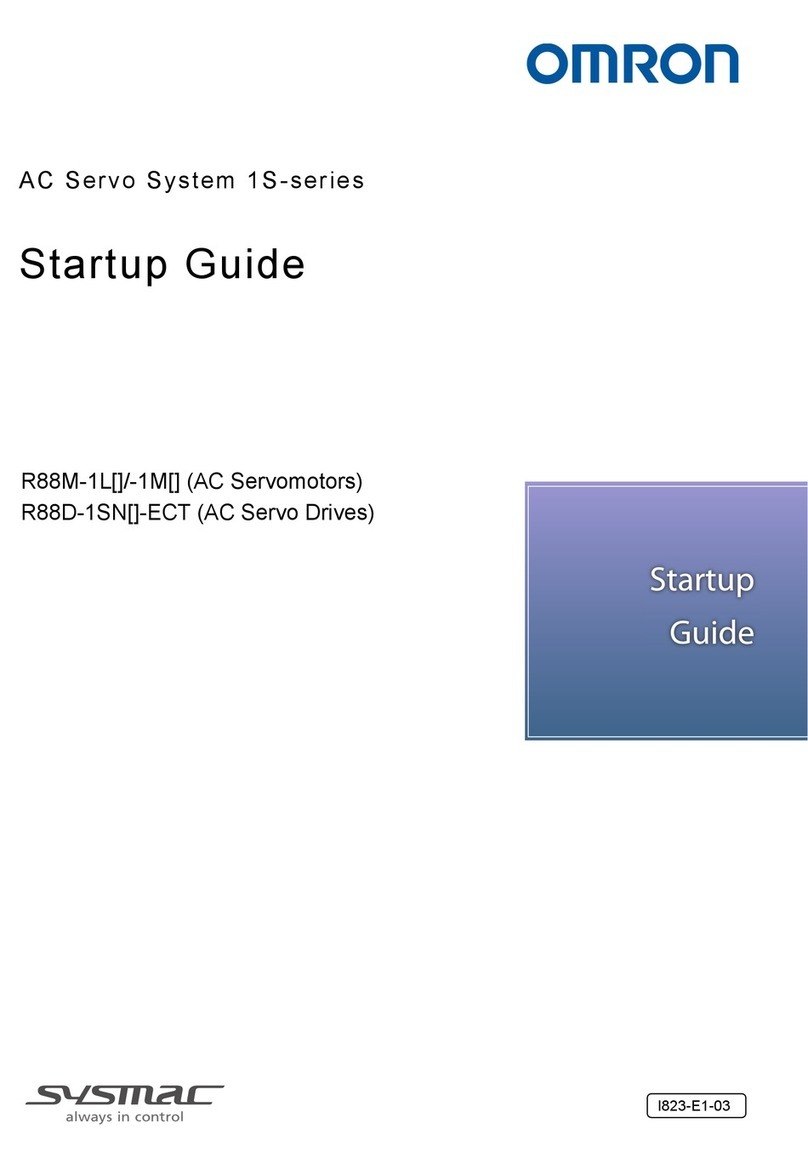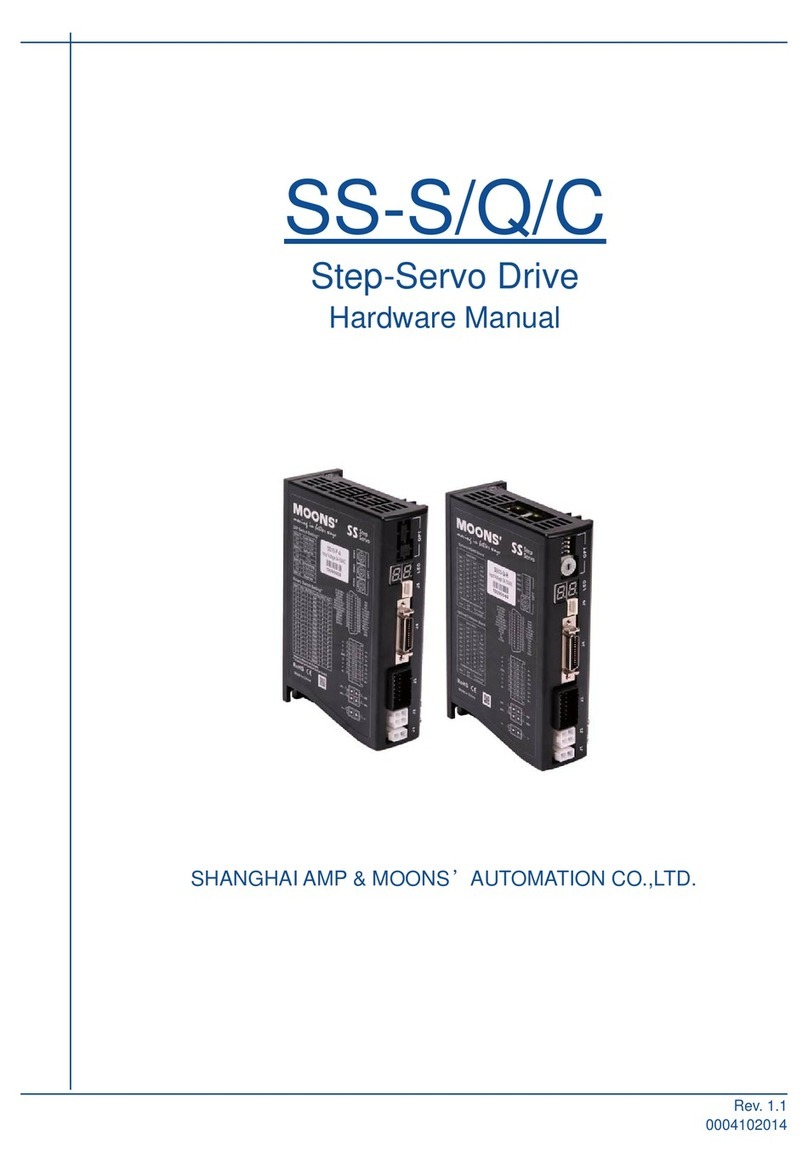GORBEL G-Force iQ Series User manual

IMPORTANT!
DO NOT DESTROY
Installation &
Operation Manual
Month Year
Gorbel®Dealer
Date
G-Force®
Q and iQ Series
Gorbel®Customer Order No. / Serial No.
®
Go to www.gorbel.com/support/warrantyregistration.aspx
to register your G-Force®, sign up for our Platinum
Service Package and request your free G-Force® Q and
iQ Series Service Manual.

This page intentionally left blank.

TABLE OF CONTENTS
Safe Hoist Operating Guidelines......................................................................................... 1-3
Introduction.............................................................................................................................4
Correct G-Force® Installation Orientation..............................................................................5
G-Force® Main Assembly Component Description ...............................................................6
Installation
Step 1 - Unpacking the G-Force®..................................................................................................... 7
Step 2 - Pre-Assembly / Tools Required........................................................................................... 7
Step 3 - Actuator Assembly Installation ............................................................................................ 7
Step 4 - Coil Cord Installation ........................................................................................................... 8
Step 5A - In-Line Slide & Force Sensing Slide Handle Installation..................................................... 9
Step 5B - Remote Mounted Slide Handle Installation .................................................................... 9-10
Step 5C - Suspended Pendant Handle Installation ........................................................................... 11
Step 5D - Remote Mounted Pendant Handle Installation............................................................. 11-12
Step 5E - 1320 Lb. In-Line Slide or Remote Mounted Handle Installation ....................................... 13
Step 5F - 1320 Lb. Suspended Pendant Handle Installation ............................................................ 14
Step 5G - 1320 Lb. Air Hose Installation (Option) ............................................................................. 14
Step 5H - Remote Mount Force Sensing Slide Handle Installation................................................... 15
Step 5I - Remote Mount Force Sensing Hub Handle Installation .................................................... 16
Step 6 - Electrical Power Connection.............................................................................................. 17
Step 7 - Initial Power-Up ................................................................................................................. 17
Step 8 - Float Mode and Final Steps ......................................................................................... 18-19
Step 9 - Expansion I/O Block Mounting Instructions (Option)......................................................... 20
Lift Functionality ...............................................................................................................21-23
Controls Interface Features..................................................................................................24
Program Mode
Overview & Basic Features............................................................................................................ 25-29
Custom Feature Definition and Requirements ............................................................................... 30-35
Input/Output Points......................................................................................................................... 36-41
Troubleshooting
Basic Troubleshooting......................................................................................................................... 42
System Fault Diagnostics Chart.......................................................................................................... 43
Diagnostic Mode Test Chart................................................................................................................ 44
Technical Specifications.......................................................................................................45
Wire Rope Inspection, Maintenance, & Replacement .....................................................46-50
Slack Spring Adjustment ......................................................................................................51
Recommended Spare Parts Kits.......................................................................................... 52
Limited Warranty ..................................................................................................................53
Inspection and Maintenance Schedule ................................................................................ 56
Questions? Concerns? Comments? Please call (800) 821-0086 (US and Canada) or (585) 924-6262 (outside US).

This page intentionally left blank.

SAFE HOIST OPERATING GUIDELINES
General
There is no one single factor that is more important for minimizing
the possibility of personal injury to the operator and those working in
the area, or damage to property, equipment, or material than being
familiar with the equipment and using Safe Operating Practices.
Hoists/trolleys are designed for lifting and transporting of material
only. Under no circumstances, either during initial installation or in
any other use, should the hoist be used for lifting or transporting
personnel.
No operator should be permitted to use the equipment that is not
familiar with its operation, is not physically or mentally fit, or has not
been schooled in safe operating practices. The misuse of hoists
can lead to certain hazards which cannot be protected against by
mechanical means; hazards which can only be avoided by the
exercise of intelligence, care, and common sense.
Safe Operating Practices also involve a program of periodic
inspection and preventative maintenance (covered in a separate
section). Part of the operator’s training should be an awareness of
potential malfunctions/hazards requiring adjustments or repairs, and
bringing these to the attention of supervision for corrective action.
Supervision and management also have an important role to play
in any safety program by ensuring that a maintenance schedule is
adhered to, and that the equipment provided for the operators is
suitable for the job intended without violation of one or more of the
rules covering safe operating practices and good common sense.
The Safe Operating Practices shown are taken in part from the
following publications:
• American National Standard Institute (ANSI)
• Safety Standards for Cranes, Derricks, Hoists
• ANSI B30.2 - Overhead and Gantry Cranes
• ANSI B30.16 - Overhead Hoists
Do’s and Don’ts (Safe Operation of Hoists)
The following are Do’s and Don’ts for safe operation of overhead
hoists. A few minutes spent reading these rules can make an
operator aware of dangerous practices to avoid and precautions to
take for his own safety and the safety of others. Frequent
examinations and periodic inspections of the equipment as well as a
conscientious observance of safety rules may save lives as well as
time and money.
DON’TS - HOISTS
1. Never lift or transport a load until all personnel are clear and do
not transport the load over personnel.
2. Do not allow any unqualified personnel to operate hoist.
3. Never pick up a load beyond the capacity rating appearing on
the hoist. Overloading can be caused by jerking as well as by
static overload.
4. Never carry personnel on the hook or the load.
5. Do not operate hoist if you are not physically fit.
6. Do not operate hoist to extreme limits of travel of cable without
irst checking for proper limit switch action.
7. Avoid sharp contact between two hoists or between hoist and
end stop.
8. Do not tamper with or adjust any parts of the hoist unless spe-
cifically authorized to do so.
9. Never use the load cable as a sling.
10. Do not divert attention from load while operating hoist.
11. Never leave a suspended load unattended.
12. Do not use limit switch(es) for normal operating stop(s). These
are safety devices only and should be checked on a regular
basis for proper operation.
13. Never operate a hoist that has an inherent or suspected
mechanical or electrical defect.
14. Do not use load cable as a ground for welding. Never touch a
live welding electrode to the load cable.
15. Do not jog controls unnecessarily. Hoist motors are generally
high torque, high slip types. Each start causes an inrush of cur-
rent greater than the running current and leads to overheating
and current failure, or burnout, if continued to excess.
16. Do not operate hoist if load is not centered under hoist.
17. Do not operate hoist if cable is twisted, kinked, or damaged.
18. Do not remove or obscure label.
19. Do not permanently activate operator present sensor.
DO’S - HOISTS
1. Read and follow manufacturer’s instruction, installation, and
maintenance manuals. When repairing or maintaining a hoist,
use only manufacturer’s recommended parts and materials.
2. Read and follow all instruction and warning information on or
attached to a hoist.
3. Remove the hoist from service and thoroughly inspect and
repair, as necessary, if unusual performance or visual defects
(such as peculiar noise, jerky operations, travel in improper
direction, or obviously damaged parts) are noticed.
4. Establish a regular schedule of inspection and maintain records
for all hoists with special attention given to hooks, load cables,
brakes, and limit switches.
5. Check operation of brakes for excessive drift.
6. Never lift loads over people, etc.
7. Check for damaged hooks and load cable.
8. Keep load cable clean and well maintained.
9. Check the load cable for improper seating, twisting, kinking,
wear, or other defects before operating the hoist.
10. Make sure a load clears neighboring stockpiles, machinery, or
other obstructions when raising, lowering, or traveling the load
11. Center hoist over the load before operating.
12. Avoid swinging of load or load hook when traveling the hoist.
13. Be sure the load attachment is properly seated in the saddle of
the hook. Balance load properly before handling. Avoid hook tip
loading.
14. Pull in a straight line, so that neither hoist body nor load cable
are angled around an object.
15. Take up slack slowly.
16. Know the hand signals for hoisting, cross travel, and crane
travel if working with cab-operated hoists or cranes. Operators
should accept signals of only those persons authorized to give
them.
19/18 - Rev. U

29/18 - Rev. U
G-FORCE® OPERATIONAL GUIDELINES
All operators should read the G-Force® Installation and Operation Manual before
operating the unit. Please follow the instructions contained in this manual for your
safety and the optimum trouble-free operation of your G-Force®.
Read & follow all
instruction & warning
information on or attached
to the G-Force®.
Check Wire Rope for
improper seating, twisting,
kinking, wear or defects
before operating.
Center G-Force® over
the load before lifting
a load. Do not end
or side load.
Avoid swinging of load
or load hook when
traveling with the
G-Force®.
Check the coil cord for
improper seating, twisting,
kinking, wear or defects
before operating.
The operator’s hand should not
leave the handle grip at any
time the G-Force® is in use
(excluding Float Mode).
Float Mode - Press the G-Force®
logo button with only the load weight
handing from the unit. Applying
additional force will cause unit to drift.
The wire rope should never be
more than 15° out of vertical
while the G-Force® is in use. The
G360™ must be level at all times.
Do not impact the G-Force®
into end stops repeatedly or at
a speed faster than a normal
walking pace.
Maximum Trolley Saddle for the
G-Force® with standard in-line slide
handle is 14’. See above drawing
for Trolley Saddle defi nition.
The maximum available wire
rope travel for the G-Force® is
11’. For H5 duty cycle the
maximum working stroke is 8’.
Questions about G-Force®?
Call your local Gorbel®
distributor or Gorbel® Customer
Service at (800) 821-0086.
G-Force®
Installation &
Operation
Manual
1
9 10 11 12
8765
432
What is
Trolley
Saddle?
The distance
from bottom
of wheels to
fl oor.
Maximum
Trolley
Saddle is
14’.
11’ ?

WARNINGS
TOOLING INTEGRATION GUIDELINES
IMPORTANT SAFETY INSTRUCTIONS
1. All operators should read the G-Force®Installation and Operation Manual before operating
the unit.
2. Check wire rope for improper seating, twisting, kinking, wear, or defects before operating.
3. Center the G-Force®over the load before lifting. DO NOT end or side load the G-Force®.
End or side loading will seriously reduce the life of the wire rope and lead to premature
failure. The wire rope should never exceed an out of vertical angle greater than 15° under
any circumstances.
4. Avoid swinging of load or load hook when traveling with the G-Force®.
5. Check the coil cord for improper seating, twisting, kinking, wear, or defects before operating.
Any of the described conditions will seriously reduce the life of the coil cord and lead to
premature failure.
6. Press the G-Force®logo button for Float Mode (option) with only the load weight hanging
from the unit. Additional external forces applied to the load during initiation of Float Mode will
result in the load drifting.
7. Do not repeatedly impact the G-Force®into the end stops. This condition will seriously
reduce the life of the controls and could lead to premature failures. If the unit impacts the end
stop more than 10 times in a single shift, contact Gorbel®Inside Sales for alternative end
stop options.
8. The G-Force®does not meet “wash-down” environment requirements. The G-Force®does
not meet “explosion proof” requirements.
9. Ensure that the slide handle is supported properly in remote mounted handle applications by
mounting the slide handle at both the top and bottom mounting points (diagram D, page 23).
10. Do not mount any objects to the G-Force®slide handle grip (i.e. switches). Additional objects
may interfere with the travel of the sliding handle grip and affect the overall speed and
functionality of the unit.
11. Do not mount any load bearing components to the blue housing of the G-Force®slide
handle, pendant handle, or actuator assembly.
WARNINGS
1. All tooling must be retained to the G360™ assembly utilizing the M16 thread and locking pin
provided. The locking pin is optional on Slide Handle and Wire Rope Swivel assemblies if
proper inspection and maintenance procedures are followed.
2. Do not mount anything to the G-Force®handle housing. Use supplied brackets, valves, and
switches whenever possible.
3. In-line tooling must always be centered directly under the hand controller.
4. Tooling design which does not keep the tooling level; and balanced in both the loaded and
unloaded condition may induce a bending force on the handle and/or collector assembly
which may reduce the life and/or performance of the handle and/or collector assembly
5. Do not mount anything to the sliding portion of the G-Force®hand controller.
6. Do not alter or add conductors to the G-Force® coil cord.
7. Use only Gorbel’s slide on air hose (slides over coil cord) to supply air power to end effector
tooling. Gorbel cannot guarantee performance or functionality of other methods of supplying
air power to end effector tooling.
8. All cables used in a remote mounted handle configuration must be properly clamped and/or
strain-relieved to prevent premature failure of the G-Force® or customer tooling.,
39/18 - Rev. U

INTRODUCTION
Thank you for choosing a Gorbel® G-Force® Intelligent Lifting Device (ILD)** to solve your material han-
dling needs. The G-Force® is a servomotor driven, high speed, ergonomic materials handling device. The
innovative design and heavy-duty construction of the G-Force® will provide a superior quality product that
will offer years of long term value. A Gorbel® G-Force® will provide many years of dependable service by
following the installation and maintenance procedures described herein.
** U.S. Patent No’s: 5,865,426, 6,622,990, 6,386,513, & 6,886,812, Other Patents Pending
Dimensions contained in this installation manual are for reference only and may differ for your
particular application.
WARNING
Only competent erection personnel familiar with standard fabrication practices should be employed to
install the G-Force® because of the necessity of properly interpreting these instructions. Gorbel is not
responsible for the quality of workmanship employed in the installation of this hoist according to these
instructions. Contact Gorbel, Inc., at 600 Fishers Run, P.O. Box 593, Fishers, New York 14453, 1-585-
924-6262, for additional information if necessary.
WARNING
Equipment described herein is not designed for, and should not be used for, lifting, supporting, or trans-
porting humans. Failure to comply with any one of the limitations noted herein can result in serious bodily
injury and/or property damage. Check Federal, State and Local regulations for any additional require-
ments.
WARNING
Prior to installation, consult a qualified structural engineer to determine if your support structure is ade-
quate to support the loadings created during normal operation of the G-Force®.
WARNING
Reference American Institute of Steel Construction (AISC) Manual of Steel Construction (9th edition), Part
5, Specification for Structural Joints using ASTM A325 or A490 Bolts (section 8.d.2) for proper procedure
to follow when using any torque tightening methods.
WARNING
Do not field modify the G-Force® actuator or handles in any way. Any modification, without the written
consent of Gorbel, Inc., will void warranty.
WARNING
The jog switch buttons are for system maintenance and load testing only, and should not be manipulated
during normal operation of the G-Force®. Operation of the jog switch buttons during normal operation
increases the risk of personal injury to the operator.
49/18 - Rev. U
WARNING
Gorbel Inc. authorizes use of wire rope only as supplied by Gorbel for any G-Force® equipment. Use of
other than Gorbel supplied wire rope shall void Gorbel’s warranty of the product.
WARNING
This produc
t can expose you to chemicals, including acrylonitrile
,
which are
known to the State of California to cause cancer. For
more inf
ormation go to:
www.P65Warnings.ca.gov

CORRECT G-FORCE®INSTALLATION ORIENTATION
In-Line Slide Handle Remote Mounted Slide Handle
Remote Mounted Pendant Handle Suspended Pendant Handle
WARNING
The G-Force® was designed and fully life tested in the installation orientations shown above. Any
modification to the installation orientation of the G-Force® without the written consent of Gorbel, Inc.
Engineering will immediately void the warranty.
CAUTION
As a normal safety precaution, check for obstructions in the crane and G-Force® travel.
59/18 - Rev. U

G-FORCE®MAIN ASSEMBLY COMPONENT DESCRIPTION
Prior to installing the G-Force® it is a good idea to familiarize yourself with the main components.
Standard Assembly: The G-Force® consists of three (3) main assemblies and they are as
follows:
1) Actuator (diagram 1): The actuator assembly contains
the lifting power transmission of the G-Force®. The drive
assembly of the actuator consists of the servomotor with
failsafe brake, gearbox, main drum pulley, and controls.
The actuator assembly also contains the upper and lower
limit switches. See the Lift Functionality section (page
21) and Controls Interface Features section (page
24) for additional details.
2) Coil Cord Assembly (diagram 2): The coil cord assembly
carries signals from the handle to the actuator assembly
which will include lift speed, lift direction and emergency
stop. Do not restrain coil cord to any foreign objects. Do not hang or
strain relief additional cable or festooning from the Gorbel® coil cord.
3) Handle (diagram 3): The handle is the main interface between the
operator and the lifting device. See the Lift Functionality section
(page 21) and Controls Interface Features section (page 24) for
additional functionality located at the handle. The Gorbel® slide
handle can accommodate either a Gorbel® load hook or tooling
(supplied by others). Tooling must meet the guidelines set forth by
Gorbel, Inc (see Tooling Integration Guidelines on page 3). Improper
tooling integration will result in degraded performance and premature
failure of the G-Force®.
WARNING
The quick disconnects on the coil cord are keyed. The connector must
be aligned correctly before it threads into place.
WARNING
Do not field modify the G-Force® in any way. Any modification, without the written consent of Gorbel, Inc.,
will void warranty.
WARNING
The unique serial number for this unit can be found on the front cover of this manual, the bottom of the
actuator assembly and the handle. Always have this serial number available during all
correspondence regarding your G-Force®, or when ordering repair parts.
Diagram 3A. Standard 300 KG Actuator Assembly
Diagram 1. Actuator Assembly.
Diagram 2. Standard Coil
Cord Assembly.
Diagram 3. In-line Slide
Handle and Pendant Handle.
69/18 - Rev. U

INSTALLATION
STEP 1 - UNPACKING THE G-FORCE®
1.1 Carefully remove all items from the box.
1.2 Verify that all components listed on the packing slip are included.
1.3 If any items are missing or were damaged during shipping, please contact Gorbel® Inside
Sales immediately at (800) 821-0086 or (585) 924-6262.
STEP 2 - PRE-ASSEMBLY / TOOLS REQUIRED
2.1 Read entire Operator’s Manual before beginning installation of the G-Force®.
2.2 Tools and materials (by others) typically needed to install/assemble a G-Force® are as follows:
• 5mm Allen wrench • 19mm hex socket
• 8mm Allen wrench • Plastic cable tie straps
• 2.5mm Allen wrench • Ladders/man lifts
• 6mm Allen wrench (1320 lb only) • 14mm wrench or hex socket (1320 lb. only)
• 3mm Allen wrench (1320 lb only) • Snap ring pliers (1320 lb. only)
STEP 3 - ACTUATOR ASSEMBLY INSTALLATION
3.1 The standard G-Force® will come with the wheels
pre-assembled to the actuator trolley (diagram 3A).
When a Gorbel® G-Force® is to be used on a
non-Gorbel® bridge system, a universal adapter trolley is
required (diagram 3B). Note: The customer must provide
two (2) hoist trolleys when the unit will run in a
non-Gorbel® bridge system.
3.2 Ensure the power cord from the actuator is facing the
festooning side of the bridge/monorail. Remove the end
stop from the bridge and install the G-Force® actuator into
the track. Immediately reinstall the end stop. Verify that
the G-Force® trolley wheels are correct for the style and
capacity track that the unit is being installed on by rolling
the actuator assembly along the full length of the bridge to
ensure that the travel is smooth throughout.
TIP: Packing list can be found in plastic pocket attached to shipping box.
WARNING
DO NOT lift the actuator by grabbing the blue plastic end covers. To lift the actuator, grab the handle slots
in the trolley.
Diagram 3A. Standard 300 KG Actuator Assembly
Diagram 3A. Standard Actuator Assembly.
Diagram 3B. Standard 300 KG Actuator Assembly with Universal Adapter Trolley
Diagram 3B. Standard Actuator Assembly
with Universal Adapter Trolley.
79/18 - Rev. U

STEP 4 - COIL CORD INSTALLATION (STANDARD IN-LINE SLIDE HANDLE,
REMOTE MOUNTED SLIDE HANDLE & REMOTE MOUNTED PENDANT HANDLE)
Note: G-Force® units, standard in-line or remote mounted, that are ordered from the
factory will be shipped with the coil cord assembled to the actuator wear ring and the
coil cord footer, creating the coil cord assembly (diagrams 4A and 4B). In addition,
units ordered with air power will have a 1/4” ID nycoil air hose coil cord assembled
onto the coil cord assembly (not shown).
4.1 Verify the coil cord assembly is correct. There are two coil cord
assemblies: standard and double length. The standard coil cord assembly
is used on systems with a trolley saddle up to 14’ (4.27m) and will measure
approximately 8.3” (211.46mm) in length. The double length coil cord
assembly is used on systems with a trolley saddle greater than 14’
(4.27m) and will measure approximately 16.4” (415.93mm) in length.
4.2 Feed the wire rope from the actuator assembly through the center of the
coil cord assembly.
4.3 Use the actuator assembly hardware to fasten the coil cord assembly to
the actuator (diagram 4C). Adjust the coil cord in the clamps so that the
coil cord connector is conveniently located on the proper side of the
actuator assembly. Note: The orientation of the coil cord must be correct
so that the connector is located properly (diagram 4D).
4.4 Thread the coil cord connector into the actuator connector (diagram 4D).
4.5 Assure that the coils of the coil cord are
centered around the wire rope when
properly installed.
4.6 Use the 16mm shoulder bolt and M12
jam-nut to retain the coil cord footer to the
thimble in the wire rope. Note: The
shoulder bolt and jam-nut will be used to
retain the handle or collector in the next
step.
4.7 If applicable, connect air hose coil cord to
supply line from the actuator assembly.
The air hose coil cord is provided with
two (2) 1/4” NPT male swivel fittings
located at both ends of the air hose.
4.8 For standard in-line slide handle or in-line force sensing handle installation, go to Step 5A, page 9.
For remote mounted slide handle installation, go to Step 5B, page 9.
For suspended pendant handle installation, go to Step 5C, page 11.
For remote mounted pendant handle installation, go to Step 5D, page 11.
For 1320 lb. in-line slide or remote mounted handle installation, go to Step 5E, page 13.
For 1320 lb. suspended pendant handle installation, go to Step 5F, page 14.
For remote mounted force sensing handle installation, go to Step 5H, page 15.
For remote mounted force sensing hub handle installation, go to Step 5I, page 16.
TIP: This step is best completed once the actuator has been installed into the bridge system.
Diagram 4A. Standard Coil
Cord Assembly.
Diagram 4B. Double
Length Coil Cord
Assembly.
CAUTION
The connectors on the coil cord are keyed. The connector must be
aligned correctly before it threads into place.
Diagram 4D. Coil Cord Assembly
Installation (Bottom).
Diagram 4C. Coil Cord Assembly
Installation at the Actuator
(black center not shown).
89/18 - Rev. U

STEP 5A - IN-LINE SLIDE & IN-LINE FORCE SENSING HANDLE INSTALLATION
5A.1 Ensure the wire rope is still fed through the center
of the coil cord. Hold the slide handle just below
the coil cord.
5A.2 Center the coil cord footer between the ears of
the slide handle swivel. Note: Make sure the fin
of the coil cord footer is on the opposite side of
the slide handle connector.
5A.3 Remove the 16mm shoulder bolt from the coil
cord footer and wire rope and allow the coil cord
footer and wire rope to slide down into the slide
handle swivel.
5A.4 Once the wire rope, coil cord footer and slide handle swivel are aligned,
replace the 16mm shoulder bolt, thereby capturing the wire rope, coil
cord footer and slide handle (diagram 5A1).
5A.5 Thread the coil cord connector into the slide handle connector (diagram
5A1).
5A.6 Thread the M12 jam nut onto the 16mm shoulder bolt.
5A.7 Check that the coils of the coil cord are centered around the wire rope
when properly installed.
5A.8 Optional: Install the hook or tooling using the retaining nut and lock
washer. The included flat washer is unnecessary in this application. Use
the open pilot hole on the Slide Handle Retaining Nut and a #21 drill bit
to drill a hole completely through the threads of the hook and the opposite side of the nut. Hammer
the included M4x36mm spring into the hole until it is flush with the surface of the nut (diagram 5A2).
5A.9 Continue to Step 6 on page 17.
STEP 5B - REMOTE MOUNTED SLIDE HANDLE INSTALLATION
5B.1 Ensure the wire rope is still fed through
the center of the coil cord. Hold the
G360™ swivel just below the coil cord
assembly.
5B.2 Center the coil cord footer between the
ears of the G360™ swivel. Note: Make
sure the fin of the coil cord footer is on the
opposite side of the G360™ connector.
5B.3 Remove the 16mm shoulder bolt from the
coil cord footer and wire rope and allow
the coil cord footer and wire rope to slide
down into the G360™ swivel.
Diagram 5A. Slide Handle, Shoulder Bolt, Coil Cord.
16 mm Shoulder Bolt
M12 Jam Nut
Coil Cord Footer
Wire Rope
**COIL CORD
HAS BEEN
REMOVED FOR
CLARITY
Slide Handle Connector
Diagram 5A1. Slide Handle, Shoulder Bolt and Coil Cord
M8 Jam Nut
Coil Cord Footer
Wire Rope
16 mm Shoulder Bolt
G360 Swivel
**COIL CORD HAS BEEN
REMOVED FOR CLARITY
Diagram 5B. G360, Shoulder Bolt, Coil Cord.
STRAIN-RELIEF CLAMP - MUST BE USED
TO PREVENT DAMAGE TO G360.
Diagram 5B1. G360™, Shoulder Bolt and Coil
Cord.
99/18 - Rev. U
Diagram 5A2. Slide
Handle with Optional Pin.

STEP 5B - REMOTE MOUNTED SLIDE HANDLE INSTALLATION (CONTINUED)
5B.4 Once the wire rope, coil cord footer
and G360™ swivel are aligned,
replace the 16mm shoulder bolt
thereby capturing the wire rope, coil
cord footer and G360™ swivel
(diagram 5B1, page 9).
5B.5 Thread the coil cord connector into the
G360™ connector (diagram 5B1,
page 9).
5B.6 Thread M12 jam nut onto the 16mm
shoulder bolt.
5B.7 Check that the coils of the coil cord
are centered around the wire rope
when properly installed.
5B.8 A pilot hole is provided for the locking pin. Attach tooling to
G360™ utilizing M16 thread. The tool bolt/rod thread should be
beyond pilot hole of shaft when fully engaged. Using a #21 drill
bit, drill through the tool bolt/rod thread and out the other side of
G360™ shaft. Hammer pin into place thereby locking tooling to
G360™ (diagram 5B2).
5B.9 Assemble the remote mounted slide handle inside the remote mount
bracket using the hardware provided (diagram 5B3). Note: This step is
best completed on a workbench prior to mounting handle to tooling.
5B.10 Attach the remote mounted handle with bracket to the tooling. Assure
that the mounting arrangement does not affect the operating function
of the slide handle.
5B.11 Connect the extension cable from the G360™ to the remote mounted slide handle. Securely clamp
the remote mount coil cord extension cable to the tooling as needed.
5B.12 Continue to Step 6 on page 17.
WARNING
Remote mounted G-Force® handles must be mounted at both the
top and bottom of the handle assembly. Failure to mount the remote
mounted handle at top and bottom can result in poor performance
and/or premature component failure.
Diagram 5H. Tooling Installation.
Diagram 5B2. Tooling Installation.
Diagram 5D. Remote Mounted Slide Handle, Exploded View
2x M16 Hex Head Cap Screw
2x M16 Lockwasher
2x M16 Flatwasher
Diagram 5B3. Remote
Mounted Slide Handle,
Exploded View.
2X M16 Hex
x 30mm Lg.
Head Cap Screw
2X M16
Lockwasher
2X M16
Flatwasher
Slide Handle,
Remote Mounted
Configuration
Remote
Mount Slide
Handle
Bracket
CAUTION
Take care to avoid looping excess cable at locations where the loop could catch on foreign
objects.
CAUTION
All cables used in a remote mounted handle configuration must be properly clamped and/or strain-
relieved to prevent premature failure of the G-Force® or customer tooling.
10 9/18 - Rev. U

STEP 5C - SUSPENDED PENDANT HANDLE INSTALLATION
5C.1 Assure that the coils of the pendant handle coil cord are
centered around the pendant handle wire rope.
5C.2 Remove the eyebolt from suspended pendant cable
assembly using the threaded connector.
5C.3 Thread the eyebolt into the bottom of the actuator
assembly as shown (diagram 5C1).
5C.4 Reattach the suspended pendant cable assembly to the
eyebolt via the threaded connector.
5C.5 Adjust the suspended pendant cable assembly so that
there is a service loop in the wiring cable and there is
no tension in the wire cable.
5C.6 Thread the cable assembly connector into the actuator
connector (diagram 5C1).
5C.7 Remove the cotter pin and clevis from the wire rope
swivel assembly.
5C.8 Optional: Install the hook or tooling with the washer, lock washer and nut
in the orientation shown (diagram 5C2) then use the pilot hole and a #21
drill bit to drill through the hook threads, a minimum of 36mm deep. Use a
hammer to insert the M4x36mm spring pin into the hole until it is flush
with the surface of the swivel assembly (diagram 5C3).
5C.9 Reinsert the clevis and cotter pin capturing the wire rope thimble in the
swivel assembly (diagram 5C3).
5C.10 Continue to Step 6 on page 17.
Note: On suspended pendant equipped systems, the wire rope swivel
assembly must be installed before AC power is applied to the system
or a limit switch error will occur (501 / 11000 error codes). To clear
this fault you will have to (must be done in this order):
1. Install wire rope swivel assembly or other weighted device on
wire rope.
2. Disconnect AC power from the system (using the e-stop will
not work).
3. Reconnect the AC power and wait approximately one minute
for system to power on completely.
STEP 5D - REMOTE MOUNTED PENDANT HANDLE
INSTALLATION
5D.1 Ensure the wire rope is still fed through the center of the coil cord. Hold the G360™ swivel just
below the coil cord.
5D.2 Center the coil cord footer between the ears of the G360™ swivel. Note: Make sure the fin of the
coil cord footer is on the opposite side of the G360™ connector.
5D.3 Remove the 16mm shoulder bolt from the coil cord footer and wire rope and allow the coil cord
footer and wire rope to slide down into the G360™ swivel.
Eyebolt With Hexnut
Threaded Connector
Suspended Pendant
Cable Assembly
Cable Assembly
Connector
Actuator Connector
Diagram 5C1. Assembly of Suspended Pendant
Cable Assembly to Bottom of Actuator Assembly.
Diagram 5C3. Cotter Pin, Clevis,
Wire Rope Swivel Assembly and
Wire Rope Thimble.
119/18 - Rev. U
Diagram 5C2. Hook
installation.

STEP 5D - REMOTE MOUNTED PENDANT HANDLE INSTALLATION (CONTINUED)
5D.4 Once the wire rope, coil cord footer and
G360™ swivel are aligned, replace the
16mm shoulderbolt thereby capturing the
wire rope, coil cord footer and G360™
swivel (diagram 5D1).
5D.5 Thread the coil cord connector into the
G360™ connector (diagram 5D1).
5D.6 Thread the M12 jam nut onto the 16mm
shoulder bolt.
5D.7 Check that the coils of the coil cord are
centered around the wire rope when
properly installed.
5D.8 A pilot hole is provided for the locking pin.
Attach tooling to G360™ utilizing M16
thread. The tool bolt/rod thread should be
beyond pilot hole of shaft when fully
engaged. Using a #21 drill bit, drill through
the tool bolt/rod thread and out the other
side of G360™ shaft. Hammer pin into
place thereby locking tooling to G360™
(diagram 5D2).
5D.9 Attach the pendant handle bracket directly
to the tooling. Assure that the mounting
arrangement does not affect the operating
function of the pendant handle. Note: If
necessary, a collar clamp mounting bracket
option can be used to attach the pendant
handle to the tooling (diagram 5D3).
5D.10 Connect the extension cable from the
G360™ to the remote mounted pendant
handle. Securely clamp the remote mount
coil cord extension cable to the tooling as
needed.
5D.11 Continue to Step 6 on page 17.
16 mm Shoulder Bolt
M8 Jam Nut
Wire Rope
Coil Cord Footer
G360 Swivel
**COIL CORD HAS BEEN
REMOVED FOR CLARITY
Diagram 5G. G360, Shoulder Bolt, Coil Cord
STRAIN-RELIEF CLAMP - MUST BE USED
TO PREVENT DAMAGE TO G360.
Diagram 5D1. G360™, Shoulder Bolt and Coil Cord.
CAUTION
Take care to avoid looping excess cable at
locations where the loop could catch on
foreign objects.
CLAMP COLLAR
REMOTE MOUNTED PENDANT HANDLE
Diagram 5D3. Remote Mounted Pendant Handle with Collar
Clamp Mounting Bracket (Option).
Diagram 5H. Tooling Installation.
Diagram 5D2. Tooling Installation.
CAUTION
All cables used in a remote mounted handle
configuration must be properly clamped and/
or strain-relieved to prevent premature failure
of the G-Force® or customer tooling.
12 9/18 - Rev. U

STEP 5E - 1320 LB. INLINE SLIDE & REMOTE MOUNTED HANDLE INSTALLATION
5E.1 With the actuator hanging from rail or other support
structure, thread the free end of the wire rope through the
wear ring bracket and use the supplied hardware to
attach the bracket to the actuator.
5E.2 Thread the free end of the wire rope through the coil cord
assembly so it hangs below the coil cord mounting plate
and attach the wear ring bracket using the supplied
hardware (diagram 5E1).
5E.3 Insert Turck connector on coil cord into mating connector
on the underside of the actuator.
5E.4 Grab the free end of the wire rope and loop it up towards
the underside of the actuator, ensuring there are no twists
or kinks in the rope. Feed the U-bolt through the wire
rope thimble and insert the U-bolt into the appropriate
holes in the reinforcement plate. Using supplied hexnuts,
securely tighten U-bolt to the plate (diagram 5E2).
5E.5 Attach the plate to the underside of the actuator using
the supplied cap screws, lockwashers, and spacers as
shown and ensure hardware is now completely
tightened. (If an air hose is being installed, leave
hardware loose for now.)
5E.6 While holding the handle or G360™, loop the pulley
through the wire rope and slip the pulley and side
spacers down between the plates (diagram 5E3, page
14).
5E.7 Align the holes in the plates with the spacers and the
bearings, insert the pulley pin, and install the snap ring
on the pulley pin.
5E.8 Using the supplied cap screws and lockwashers, attach
the coil cord mounting plate to the top of the handle or
G360™.
5E.9 Attach the coil cord Turck connector to the mating connector in the top of the handle or G360™
and use the supplied cap screw to attach the strain relief clamp to the side plate so there is a small
service loop at the connector.
5E.10 Continue to Step 6 on page 17.
2X 65112
2X 03370
2X 79150
WEAR RING
(76764)
2X 03370
2X 65028
COIL CORD
2X 79150
2X 65032
83253
65032
79150
WIRE ROPE ASSEMBLY
Diagram 5E1. Assembly of Wire Rope to
1320 lb. Actuator Assembly.
4X 83260
83252
4X 00195
4X 83236
83265
4X 02158
2X 01355
NOTE: COIL CORD AND ASSOCIATED COMPONENTS
NOT SHOWN FOR CLARITY
Diagram 5E2. Attaching U-bolt and
Reinforcement Plate to Actuator Assembly.
139/18 - Rev. U

STEP 5F - 1320 LB. SUSPENDED PENDANT HANDLE INSTALLATION
5F.1 With the actuator hanging from rail or other support
structure, thread the free end of the wire rope
through the wear ring bracket and use the supplied
hardware to attach the bracket to the actuator
(diagram 5E1, page 13).
5F.2 Thread the free end of the wire rope through the
wear ring and attach the wear ring to the wear ring
bracket using the supplied hardware.
5F.3 Grab the free end of the wire rope and loop it up
towards the underside of the actuator, ensuring there
are no twists or kinks in the rope. Feed the U-bolt
through the wire rope thimble and insert the U-bolt
into the appropriate holes in the reinforcement plate.
Using supplied hexnuts, securely tighten the U-bolt
to the plate (diagram 5E2, page 13).
5F.4 Attach the plate to the underside of the actuator using the supplied cap screws, lockwashers and
spacers as shown and ensure hardware is completely tightened. (If an air hose is being installed,
leave hardware loose for now).
5F.5 Insert eyebolt at the end of the pendant cable into the threaded hole on the reinforcement plate
and tighten. Insert Turck connector into mating connector or the underside of the actuator.
5F.6 While holding the G360™, loop the pulley through the wire rope and slip the pulley and side
spacers down between the plates (diagram 5E3).
5F.7 Align the holes in the plates with the spacers and the bearing, insert the pulley pin, and install the
snap ring on the pulley pin.
5F.8 Using the supplied cap screws and lockwashers, attach the coil cord mounting plate to the top of
the G360™.
5F.9 Continue to Step 6 on page 17.
STEP 5G - 1320 LB. AIR HOSE ASSEMBLY INSTALLATION (OPTIONAL)
5G.1 The air hose assembly comes attached to the wear ring and coil cord mounting plate. Once the
handle installation is complete, the air hose should be installed.
5G.2 Remove two of the screws and lockwashers holding the reinforcement plate to the underside of the
actuator (leaving the spacers in place) and insert them through the air hose bracket and reattach to
the underside of the actuator. Tighten all hardware.
5G.3 At the handle or G360™, insert the male swivel fitting at the end of the air hose into the female
end of the elbow in the footer and tighten.
5G.4 Connect the bulkhead fitting on the underside of the actuator to shop air and check for leaks.
4X 65018
4X 65052
83255 (PULLEY)
83261 (BEARING)
65086 (SNAP RING)
2X 83259
2X 2001.12
83258
Diagram 5E3. Attaching Wire Rope to Pulley.
14 9/18 - Rev. U

STEP 5H - REMOTE MOUNT FORCE SENSING SLIDE HANDLE INSTALLATION
5H.1 Follow Steps 5B.1 through 5B.7 on
pages 9 and 10 to install G360™.
5H.2 Bracket (by others) must be sized to fit
the handle it will be holding and rigid
enough to resist the forces exterted on
it (diagram 5H1).
5H.3 Using the included M16 hardware,
fasten both ends of the handle to the
bracket. Attach bracket to tooling if
necessary.
5H.4 Connect cable from G360™ to handle
top. Clamp the cable to tooling to
prevent it from being snagged.
5H.5 Continue to Step 6 on page 17.
Note: The system cannot support two Force
Sensing Handles running
simultaneously on one G-Force®. If
dual handles are required, one Force
Sensing Handle and one traditional handle is a supported
configuration.
Note: Due to the nature of the Force Sensing Slide Handle, excessive
twisting of the grip may be interpreted as intented motion. For
best results, only push and pull the handle grip while avoiding
twisting (diagram 5H3).
Note: To avoid damaging the handle, do not apply more than 200 lbs
(90 kg) to the grip or handlebars.
Note: Remote handles must be mounted rigidly in order to function
correctly. For Slide handles, the mounting holes on the tooling must be aligned to
avoid any binding of the handle and the bolts at each end of the handle must be
tightened enough to prevent motion but not induce bending. The included rubber
washers must be mounted between the handle and tooling to prevent binding.
Additionally the handle must be captured via the hole in the top cap to prevent
rotation (see diagram 5H2 for suggested bracket dimensions). For Hub handles,
the back of the handle body must be securely fastened to the tooling.
Note: Do not attach anything to the grip of the Slide Force Sensing Handle as
performance will be degraded.
Note: Changing the orientation of the handle (tilting) while the system is live may be
interpreted as intent to move. It is recommended that the handle remains vertical
at all times during use.
Note: When taring the handle, care must be taken not to apply force to the grip or
handlebars as subsequently removing the force will be interpreted as intent to
move.
Note: For optimal performance, re-taring the handle periodically may be necessary. The
interval will depend on usage.
Diagram 5H1. Force Sensing Slide Handle bracket sizes.
Diagram 5H2. Remote handle
mounting dimensions.
159/18 - Rev. U
Diagram 5H3.
Proper use of
Force Sensing
Handle grip.

STEP 5I - REMOTE MOUNT FORCE SENSING HUB HANDLE INSTALLATION
5I.1 Follow Steps 5B.1 through 5B.7 on pages 9
and 10 to install G360™.
5I.2 Mount Hub body to tooling rigidly to resist
forces exerted on it. Optional mounting plate
74136 is available. See diagram 5I1 for
dimensions for mounting directly to tooling.
5I.3 Attach handlebars to Hub. Handlebar kit
(74630) is available or handlebars may be fabricated (by
others). Optional handlebar mounting plate 74138 (with clamp
collars) or 74141 (plain for modication by integrator) are
available. See diagram 5I2 for dimensions for fabricating a
custom solution.
5I.4 Connect cable from G360™ to handle top. Clamp the cable to
tooling to prevent it from being snagged.
5I.5 Continue to Step 6 on page 17.
Note: The system cannot support two Force Sensing Handles
running simultaneously on one G-Force®. If dual handles are
required, one Force Sensing Handle and one traditional
handle is a supported configuration.
Note: Handlebars and attachments for Remote Force Sensing
Hub Handles must not exceed 25 lb (11.3 kg). For
optimal performance, handlebar assemblies should be
as light as possible. Handlebar weight in excess of 10
lbs (4.5 kg) will detract from net capacity of the G-Force®.
Note:
For optimal performance and to reduce the risk of
damaging the handle, handlebars on Remote Force
Sensing Hub Handles should not exceed 24” (0.6m) (12”
or 0.3m in either direction) in width or 24” (0.6m) from the
face of the handlebar mounting plate (diagram 5I3).
Note: To avoid damaging the handle, do not apply more than 200 lbs (90 kg) to the grip or handlebars.
Note: Remote handles must be mounted rigidly in order to function correctly. For Slide handles, the
mounting holes on the tooling must be aligned to avoid any binding of the handle and the bolts at
each end of the handle must be tightened enough to prevent motion but not induce bending. The
included rubber washers must be mounted between the handle and tooling to prevent binding.
Additionally, the handle must be captured via the hole in the top cap to prevent rotation (see
diagram 5H2, page 15, for suggested bracket dimensions). For Hub handles, the back of the handle
body must be securely fastened to the tooling.
Note: When taring the handle, care must be taken not to apply force to the grip or handlebars as
subsequently removing the force will be interpreted as intent to move.
Note: For optimal performance, re-taring the handle periodically may be necessary. The interval will
depend on usage.
Diagram 5I2. Mounting plate dimensions.
16 9/18 - Rev. U
Diagram 5I1. Mounting handlebar and mounting plate.
Diagram 5I3. Handlebar dimensions.
WARNING
This handle is only intended for remote mount
applications and must not be used for transmitting
lifting loads.
This manual suits for next models
1
Table of contents
Popular Servo Drive manuals by other brands

Parker
Parker PSD1 installation guide
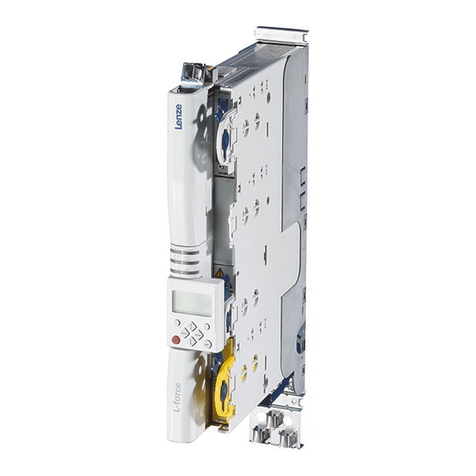
Lenze
Lenze L-force 9400 E94ASHE Series Commissioning Guide
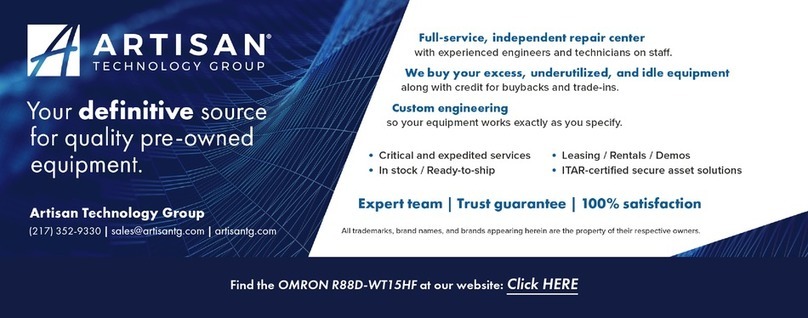
Omron
Omron OMNUC R88D-WT15HF user manual

Mitsubishi Electric
Mitsubishi Electric MELSERVO-J4 series instruction manual

Copley Controls
Copley Controls Xenus XTL Series manual
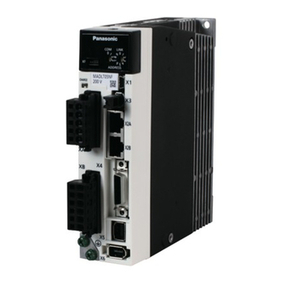
Panasonic
Panasonic MINAS A6B Series Reference Specifications
